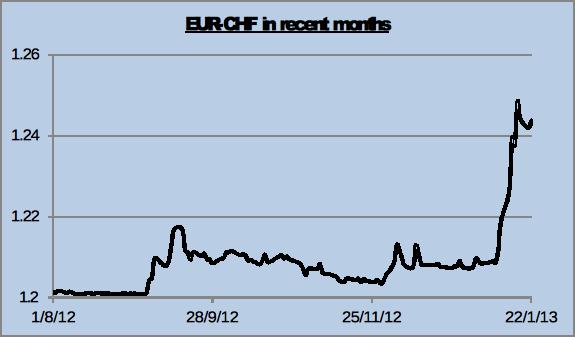By: Andrea Cohen
Lately, changes in market conditions on both sides of the EUR-CHF have brought about what we consider an opportunity to capitalize on the long-standing stagnation in the cross.
First, a reminder of the current state is in order. After a persistent appreciation in the CHF vs. the EUR from almost 1.40 prior to the Greek debt crisis outbreak to less than 1.04, the Swiss National Bank (SNB) went into action. The strengthening of the Swiss Franc (CHF) was hurting the local economy. The SNB announced that it was setting a floor on the value of the CHF at 1.2 CHF per EUR. That meant that any attempt to sell EUR-CHF will bring the SNB into the market as a buyer. With practically unlimited appetite to buy EUR, the speculative purpose of selling EUR-CHF will defeat itself as the SNB guaranteed that the price will not drop. In this manner, the SNB hoped (and succeeded) to alleviate the pressure on the CHF.

Since the second week of January, we have seen the cross moving higher and we believe this trend is worth following and favorably consider riding it. Currently, the EUR-CHF is at the 1.24 area.

The accumulation of CHF balances in local and international Swiss banks brought them to charge interest rate on positive balances. That means that for owners of CHF, it now costs money to keep to keep it in the bank. This made the short-EUR-long-CHF trade even less attractive (because of the negative carry on both sides). Charging interest on CHF deposits began with giant Credit Suisse more than a month ago, but lately local, canton-based banks joined it in doing so.
From talks with the forex trading desks at large brokers across the street, we learned that in the last few months, inflows of money to the CHF as a safe haven has diminished considerably (not to say, stopped completely). Many players internalized already how committed the SNB is to maintain the 1.20 floor. In addition, the chances of a total meltdown in Europe now seem smaller. Many who sold the EUR and bought the CHF as defense turn out to be underestimating the determination in which political and economic leaders in Europe were to maintain the monetary union intact. The probability of an exit of one of the distressed member states from the Eurozone is now considered to be close to zero, which is far from where it was a year ago. Although problems sin Spain and Greece mainly have not disappeared completely, it is clear, that the EU will go to great length and is willing to pay dearly to avoid a disorderly default and/or an exit of a state from the union, a thing that will trigger the havoc that the CHF was bought to protect investors from in the first place.
What's next?
So, will a lesser need of a Swiss safe-haven, and a way less attractive carry conditions of the CHF, where is the EUR-CHF going next?
The negative deposit rate may prove to be the straw that will break the camel’s back. According to data provided by the SNB, foreigners hold about 664 billion CHF. That’s about €500 billion. Even if a fraction of that amount is now unwound, the effect on the EUR-CHF will be very big. Even more so, with so many shorts, we assume that stop-loss triggers will be set off at 1.25, 1.30, 1.34 and 1.43. These stop-losses will accelerate the depreciation of the CHF.
We believe that buying EUR-CHF now is a favorable move now. With the inherent 1.20 floor, that’s an effective maximal loss for any risk-return calculation. In 3 months we see EUR-CHF at or above 1.30 with the crawling unwinding of short positions and CHF depreciating back to its fair levels.


